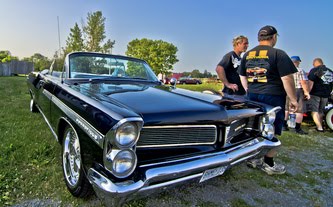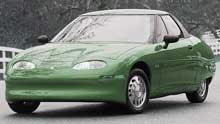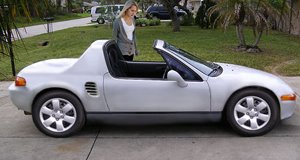 Are bright colored cars safer than dull coloured cars? I've always thought this it is a factor in safety. Here are some things I found on the web:
Are bright colored cars safer than dull coloured cars? I've always thought this it is a factor in safety. Here are some things I found on the web:http://www.asirt.org/toolbox.htm#GLOB (the site has no ref for this)
Bright-colored cars are two to four times more visible than dark cars. Especially important when driving in heavy fog, rain, or snow. Black cars are involved in 20% of all collisions, although they make up 5% of the total vehicles.
http://motorcyclecruiser.com/streetsurvival/seeme/
Riders with bright, light, solid colors stand out more and, according to good research, have fewer accidents. So why are you still wearing basic black?
You can do much to catch the visual attention of other drivers. For one, you can position yourself where you can be seen. Watch the mirrors of cars you are overtaking on the highway, and accelerate through the driver's blind spots. Also be aware of blinds spots when changing lanes on multi-lane roads. When you approach an intersection, pick a lane position that places you within the line of sight of drivers waiting to turn across your line of travel.
Dark colors are stylish and camouflage the inevitable collisions with nature and flecks of chain lube thrown up by your buddy's bike, but they make you disappear into the shadows, trees and other non-threatening bits of landscape out in the background of that driver's vision. The worst color choices are those just slightly darker than neutral -- grays, light browns, and olive drab green. The best way to disappear is to wear camouflage, which after all was designed to help the wearer hide. Flat finishes are less intrusive than glossy ones, and multi-colored patterns may actually make you less obvious because, like camo, they break up your outline.
Even 15 years later, the best source of motorcycling safety data and advice is the "Hurt Report," a government-funded study done at the University of Southern California by a group of motorcyclists led by famed accident investigator Professor Harry Hurt. That report recommended painting the front of your bike bright colors -- whites and yellows -- and wearing a bright colored jacket. Unfortunately, unlike sport bikes and touring machines, few cruisers have any significant bodywork up front to paint. You can wear a bright colored jacket and helmet, however. A single yellow, orange, or almost anything flourescent will make you pop out from the background anywhere. No, they aren't the traditional black uniform or cruisers, but you are arugged individualist, a lone wolf who doesn't have to follow the herd, and you do dare to be different, right?
http://www.aaafoundation.org/resources/index.cfm?button=carcolor
Car Color and Safety
White Paper
Need
A frequently asked question of Foundation staff is "What is the safest car color?" Psychological studies show that color has an effect on behavior, and there are other studies about color and conspicuity, but there are no studies examining the impact of car color on crash rates.
"Colors can create conditions that can cause fatigue, increase stress, decrease visual perception, damage eyesight, increase possible worker errors, and negatively affect orientation and safety" (www.colormatters.com). Studies examining traditional color psychology find blue is relaxing and red increases heart rate and blood pressure. Color affects mood and people make purchasing decisions based on color. However, it seems unlikely that a person who dislikes the color orange, for example, would purposely crash into an orange vehicle.
General studies have also been done to show the most visible colors for day and night; however, there are no studies directly addressing the relationship between car color (conspicuity) and crashes among passenger vehicles. The study below discusses colors for fire fighting equipment, and presumably it would have some relevance for passenger cars too:
It is noted that the color red, used for fire fighting equipment, is one of the least visible of vehicle colors. Optometrists note that, for its high visibility, lime yellow should be used by fire and rescue teams, as well as favored by trucks and car buyers. Lime yellow falls in the middle of the color spectrum (Schuman 1991).
Several Web sites focus on color and solicit opinions; as one might expect, the general public has many theories on color psychology. One Web site, Color Matters (www.colormatters.com), discusses the effect that color has on the mind and body. Visitors can pose questions and leave comments:
I once owned a 1980 "sand-beige" ford escort… In the 4 years that I owned the car, it was hit 11 times. Each time it was either completely stopped at a light, stop sign or parked. Apparently, this is a hard color to see, particularly on sunny days. Now, I drive a black VW and have not been in an accident in 5 years.
And:
My mother owned a silver-gray car. We noticed a significant number of near collisions on foggy morning and dusky evening hours. The silver seems to blend in with the road.
This type of speculation and frequent questions to Foundation staff underscore the timeliness of this topic. It's an obvious question to car buyers -- what color car is safest? However, it is not known if there is a relationship between car color and safety because studies have not been done.
Proposal
It is proposed that the Foundation support research to study the effects of car color on safety. A request for proposal (RFP) will suggest working with state Departments of Motor Vehicles (DMV) and AAA club-affiliated insurance companies to collect necessary data.
The relationship between car color and safety is complex. Background color (trees, desert, etc.), weather conditions (rain, fog, snow), and daylight have a profound effect on conspicuity.
At night, white is the most visible, but lime yellow stands out better against cloudy skies and snowy backdrops than does white. The color red is perceived as black at night. Also, people have particularly poor peripheral detection of red shades (Schuman 1991).
In addition, any study of the relationship between car color and crashes must consider the distribution of different colored cars on the road and whether certain colors are over or under-represented among certain types of drivers. For instance, any study that reports red cars are more prone to crashes needs to rule out higher number of red cars on the road and disproportionate numbers of bad drivers (young males) owning red cars.
Preliminary investigations indicate that some DMVs record car color. For instance, New York has registration data that includes car color and crash reports can be linked via license plate to obtain car color (see New York form in Appendix). Information on car color is not collected by most of the AAA clubs we contacted.
The contractor is expected to acquire valid data on car color and crashes in several states or localities. In determining the relationship between car color and safety, the contractor should try to go beyond process outputs, such as number of citations or arrests. Rather, the goal is to measure the crash rate -- a core outcome. Certain car colors are more likely to be caught for traffic violations (Newman and Willis 1993), but this is not the main concern of this paper.
Potential confounding variables include age, sex, weather conditions and the time of day that the crash occurred. One could envision a graph of car color and crashes, with a line for each car color juxtaposed against time of day. Are different car colors involved in crashes at different times of day? Further multivariate analyses would be done to investigate the relationship between car color and safety while controlling for potential confounding variables.
Discussion
In preparing this white paper very little information was found specifically on car color and safety. People assume that yellow is the safest color because it is used for school buses. However, when the National Conference on School Transportation chose the color at their meeting in 1939, nothing was mentioned about the expected effect on traffic safety. Similarly, many people think red is a safe and conspicuous vehicle color because fire trucks are red; again we found no research supporting this belief.
References:
Newman M, Willis FN, Bright Cars and Speeding Tickets, Journal of Applied Psychology, January 1993;23(1):79-83.
Shuman M, Traditional Red Colors Safety, National Highway Traffic Safety Administration, April, 1991;2:22-24.
Who You Callin' Yellow? Traffic Safety, September/October 2000:13.









